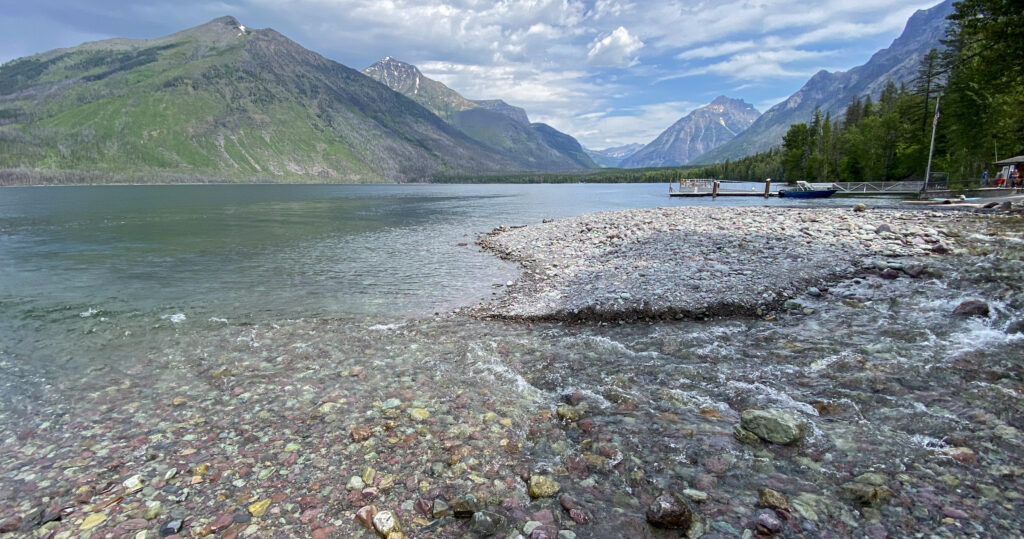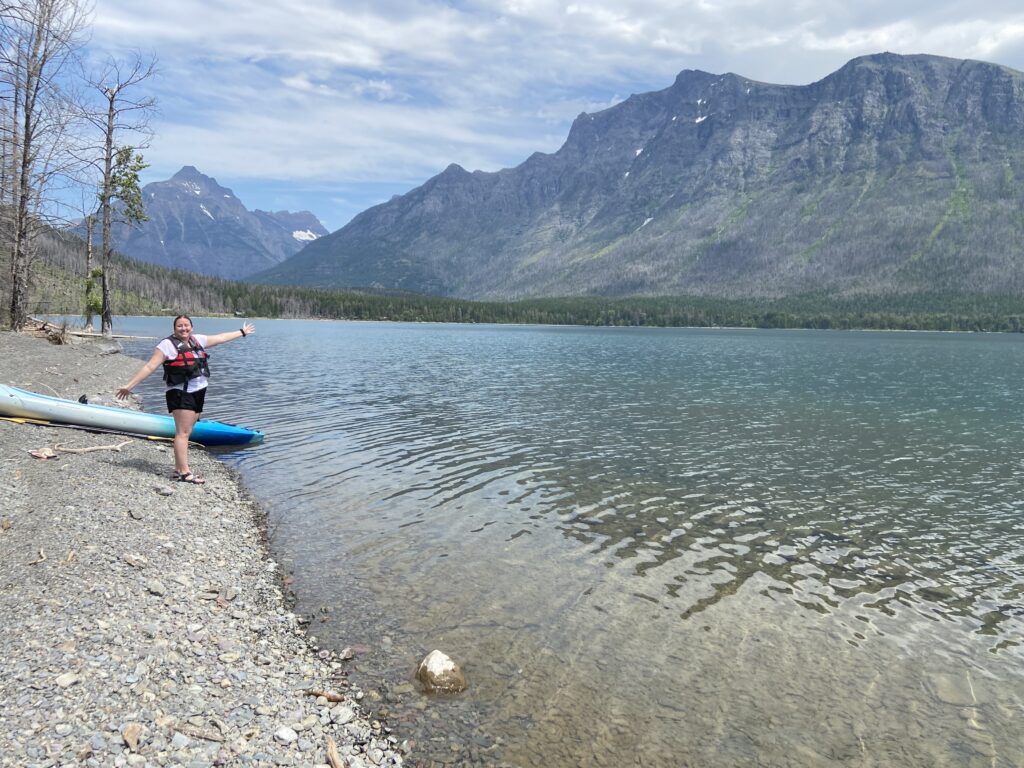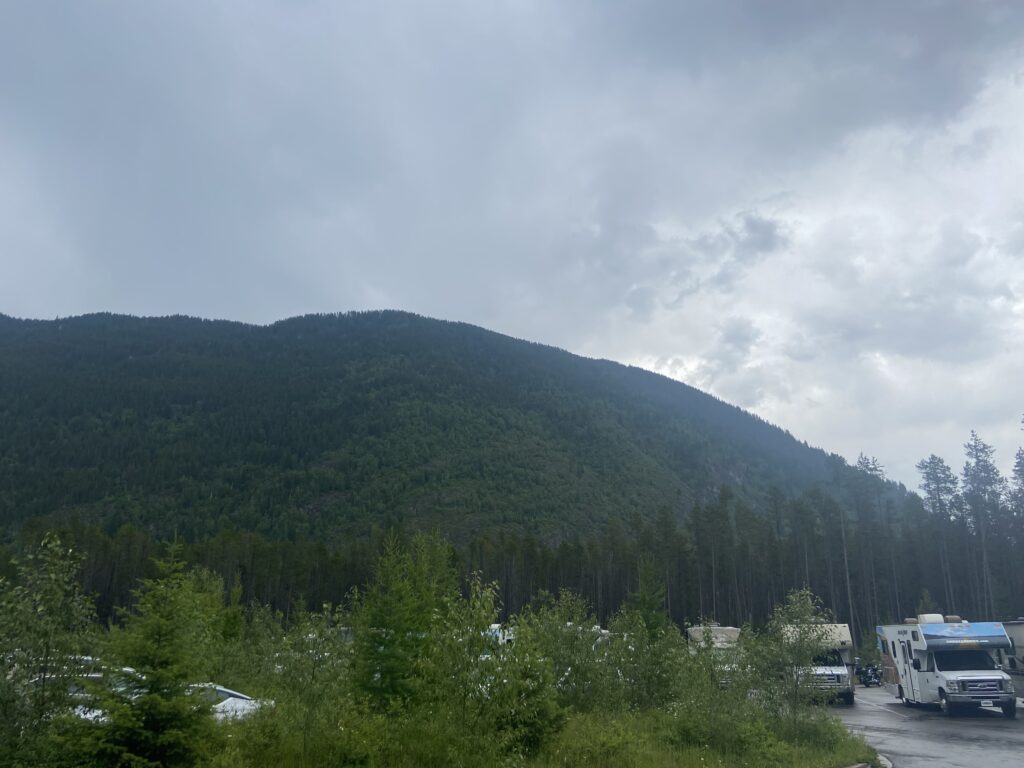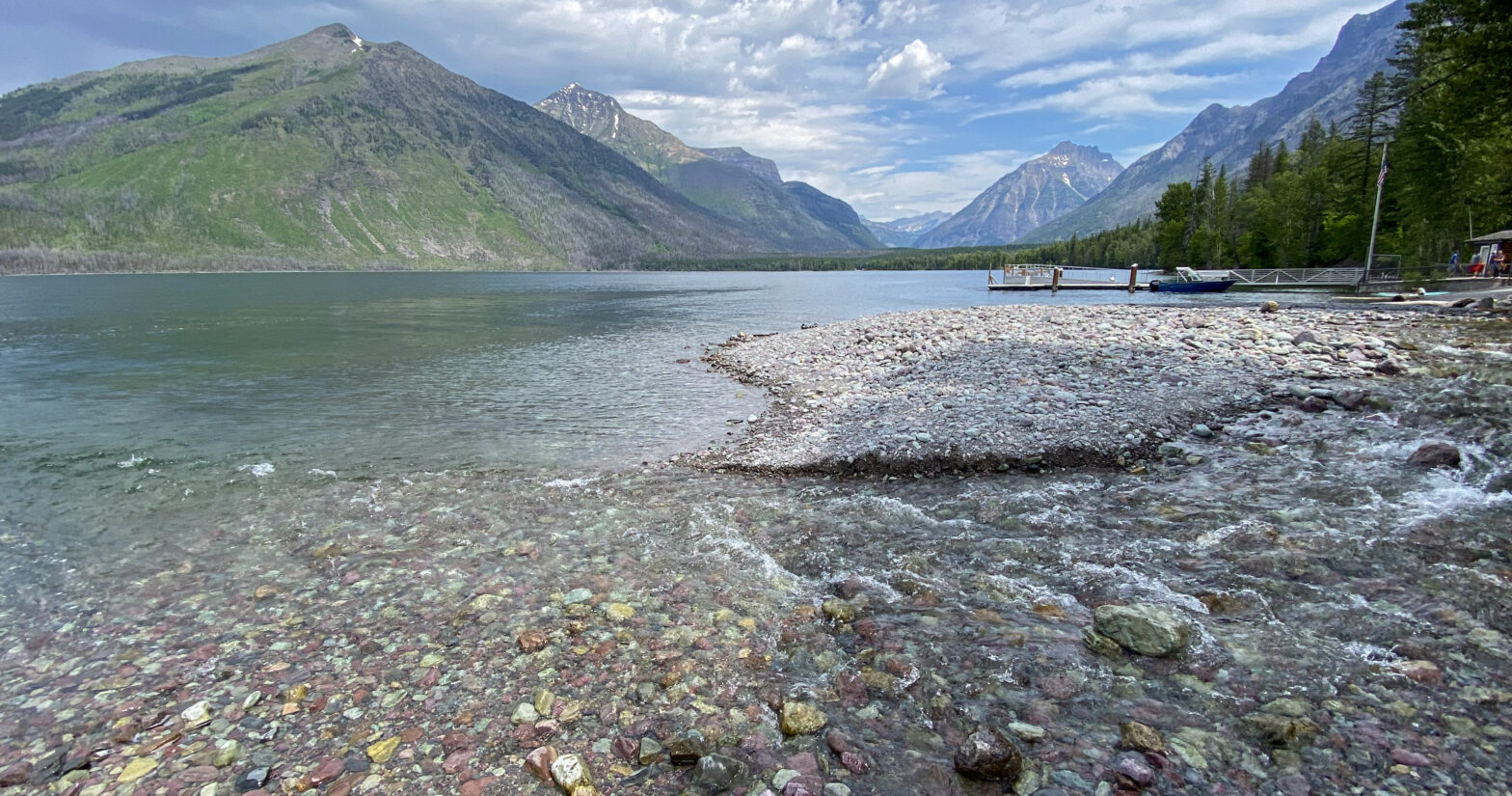When you are with someone long enough, you are able to interpret context clues much more easily. With that said, you don’t need to be an expert at Elizabeth Studies to know when she’s hungry. My lovely fiancee has a way of letting people know. And as we got back into our RAV4 on the way back from Avalanche Lake, it was hard to escape the inkling that Elizabeth was hungry. That hunch was furthered by the fact that she kept telling me that she was hungry.
Our afternoon plans involved kayaking on Lake McDonald, just a few more sparkling blue miles down McDonald Creek. Before that, we planned to have a picnic lunch somewhere along the shores of the lake. I don’t think we had a firm plan of exactly where to have the picnic, just vibes. Vibes were not going to work against Hangry Elizabeth though, so I directed her to the Lake McDonald Lodge. Lake McDonald is very long and skinny relative to other lakes in the park. It’s oriented southwest to northeast, with the entrance to the park on the southwest side of the lake and GTSR entering the alpine regions past the northeast corner at the head of the lake. The lodge is up near the head of the lake on the eastern shore. It’s a big complex of dark-brown wooden buildings that reminded me vaguely of the Signal Mountain Lodge in Grand Teton – fancy, but not Old Faithful Inn levels of fancy. It was fancy enough that lodge staff were not letting the hoi polloi inside to check out the hotel and dining room area, but at least commoners could park in one of their massive lots. Now we just needed to find a picnic table.
This proved to be a bit difficult. There were a few picnic tables on the backside of the lodge, but most were occupied. We wandered the green lawn momentarily. Across a wooden bridge that spanned a rushing creek (Snyder Creek), I spotted what we needed – a table, in a beautiful spot. It was shaded from the sun by a stand of trees and otherwise right where Snyder Creek met the waters of the lake. Perfect. Elizabeth claimed the table as the current occupants packed up to leave, delegating to me the task of returning to the car and carrying a loaded styrofoam cooler across several hundred yards of uneven ground. Muttering unkind things under my breath, I did so while Elizabeth stayed behind at the table, enjoyed the view, and ate Doritos. Hangry-ness comes with privileges.
It was a top-three spot in my life that I’ve ever picnicked. Snyder Creek was a little smaller than Avalanche Creek, which meant you could see each individual beautiful rock over which the ice-cold water flowed. Little kids frolicked among the miniature delta of rocks a few dozen yards away, and it was hard to blame them for doing so. The view? Majestic.

And the Lake McDonald Lodge had a boat dock just a few yards away where we could go look to begin our next adventure. I could see a few kayaks sitting on the beach (right side of the image). After a brief discussion, we agreed: why drive all the way to Apgar on the far side of the lake when we could just do so from here, with those beautiful mountains in the distance? But first, food.
It was a true picnic feast of – err – camping proportions. In a normal life, you’d probably never catch Elizabeth dead eating a packaged ham and salami sub from Wal-Mart, much less scarfing down her half. But she wasn’t the only one – I scarfed down my half as well. Some Doritos, some grapes, some Nature Valley bars and prepackaged Nutella snacks – I gorged on the calories to help refuel after a more-difficult-than-expected morning up to Avalanche Lake. It’s amazing how much easier vacationing in close proximity with someone else becomes once you’ve had the chance to sit down and eat some food. I could see the relief and contentment on Elizabeth’s face.
After spending some time savoring our food in that beautiful shaded cove, we lugged our now-slightly-lighter styrofoam cooler and bag of snacks back into the parking lot to the car. While there, I took some time to grab my swimsuit and water shoes from the car and stick them into Elizabeth’s Camelbak. That turned out to be a wise decision, because the boat rental people at the Lake McDonald Lodge were not very helpful. Sure, they were willing to take our money in exchange for the last double kayak sitting along the shoreline. But the attendant was curt in informing me that no, they did not have any single kayaks (dammit) or changing areas for people. We’d just have to go as we were. On the plus side, the two of us could take the double kayak anywhere we wanted within the hour we’d rented it for (plus a pro-rated amount for each additional 15 minutes, of course). I looked out at the distant western shore of Lake McDonald, about a mile or so hence, and whimsically suggested, “Why not?”
I previously blogged in 2021 about how Elizabeth and I tandem kayaked at La Jolla, California in July of 2021. It was a disaster. The two of us could never get a rhythm, and we were deeply uncomfortable with the long swells kicked up by the Pacific Ocean. This had the fixings of an easier time for the both of us. It was on a lake instead of the open ocean, and as best I know Glacier National Park is not openly shark-infested waters. However, Lake McDonald is still pretty cold, with temperatures in the mid-60s in July. And we had Elizabeth’s Camelbak, filled with precious items that I didn’t want sinking to the bottom of the lake if we capsized. In hindsight, we really should have left them along the lake, but the mean lodge employee wouldn’t let us. So it was with caution in my soul that I took the seat in the back of the kayak, the “steering seat”.
We struggled quite a bit again. I didn’t set a consistent rhythm for Elizabeth, who, left to her own devices, had a consistent list to the right. We didn’t generate a whole lot of power, either. The opposite shore of the lake appeared to be getting closer really fast early on, and then continued to stay tantalizingly out of range while we fought the small lake chop on a northwestward course. Our target was along the base of a ridge that rose sharply from the center of the lake toward its right edge, terminating in the craggy peaks of Mount Stanton and Heaven’s Peak. Here, on Howe’s Ridge, a famous wildfire several years ago has left a stand of burned-out timber that Elizabeth was convinced would allow us to see any bears before we unwarily stumbled onto their stretch of shoreline. She probably had a point.
When I wasn’t uncomfortably trying to keep Elizabeth’s Camelbak from soaking in the wake of our paddles, I had time to actually enjoy the view. This was a top-tier kayaking vista. No one else was active on the entire upper half of the lake. The sun was peaking through, backlighting the mountains and penetrating through a thin layer of haze that had drifted up from some wildfires in eastern Oregon. The thought that drifted into my mind was “best view in all of the Rockies”.
After about a half an hour of hard paddling, the rocky western shore of the lake came into sight. Fortunately, the bank wasn’t angled too badly. We paddled hard several times to get up all the steam we could, and then the kayak was biting hard into pebbles. No bears in sight, although the ridge sharply pitched upward through burned timber about 20 yards inland, so the visibility may have left something to be desired. My water shoes were coming apart, but still sufficed to get me ashore without touching anything slimy on the lake bottom. I made it to dry land and stood, drinking it all in.
They say a great way to recollect experiences is to describe things in terms of the five senses. At least three of them jumped out at me while the two of us lounged on our beachhead. The first was the obvious – sight. The Lewis Range just jumped out at you from this angle:

Thank you to the outdoors influencer/model Elizabeth for being a worthy foreground of an epic sight. And that leads into the next sense that dominated – hearing. Because there was no human within a mile of us, and it showed. The silence was deafening. It was glorious. All I could hear was the water lapping at our kayak and the occasional rustle of the breeze through the dead branches. For months, I’d gotten by in thesis defense planning by imagining the glory of Thoreau’s nature in solitude. This lived up.
The last sense I felt? Horseflies everywhere. Horseflies landing on the kayak, horseflies buzzing around my head, horseflies landing on my shoulder. The horseflies helped make up my mind that I’d be joining Elizabeth for a refreshing dip inside the lake itself. I’d planned for it – jamming my swimsuit inside her (now-soaked) Camelbak meant that I wasn’t gonna be getting my shorts wet. Elizabeth was gonna have to go in her daytime clothes, but that didn’t stop her. She waded out into the clear, aquamarine-tinged water until a little before waist depth then tumbled in with a scream. “Ohhhh my god, that’s cold!” Elizabeth cried, until a few seconds later when she realized that it actually wasn’t. Then all was well again. After she waded back, it was my turn. I churned my legs through the muck along the lake-bottom until I reached a similar depth, nearly stumbling on a rock along the lake bottom. Deep enough, I decided. I took a breath, leaned back, and – the most refreshing water rushed over me. It was cool, but not cold, just as Elizabeth had experienced a moment before. Not many people at that moment in time could say they were swimming in glacier runoff, but here I was. The novelty of it was my favorite part of the experience. After I sludged back on short, and the horseflies had a moment to gather for the attack, Elizabeth and I went back into the water, together this time. All for the sake of my Youtube video, of course.
Once we got back out this time, it felt like about time to return. After all, those kayaks were rentals by the 15 minutes and we needed to save all the money that we could for the rest of the trip. I threw on my shirt quickly to avoid the horseflies and bounded into the kayak. We made a wise decision this time – Elizabeth sat in the back or “steering” position of the boat, while I took the front spot required for “power”. For the first time ever, we were kayaking in the roles we were meant to be. The difference was remarkable. Before, someone would have looked at our boat and seen herky-jerky movements, frequent course corrections, and a halting pace. That same observer would have seen us cutting through the water on the way back to the lodge with the speed and grace of a wanna-be Olympian.
We had good reason to hustle. The sun had shone down on our beachhead through the occasional mid-level clouds we’d seen all morning. But as Elizabeth and I lazed along Lake McDonald’s western shoreline, delaying our return back across the lake in hopes of seeing a bear, an imperceptible shift occurred. All the way down the length of the big lake, I could see a hazy smudge. The clouds weren’t the stereotypical dark and foreboding that outlined an incoming thunderstorm. But in Colorado in 2020 and Wyoming in 2021, I’d discovered that mountain storms rarely register with you until they’re happening. If that smudge looked like rain, then we wanted to hightail it back to shore lest we get stuck in the middle of the lake in a thunderstorm.
Paddle, paddle, paddle. My shoulders strained with the effort of supplying power to the boat. The eastern shore of the lake lay tantalizingly out of reach as the storm approached. By now, a breeze had kicked up some chop in the lake, and a slow patter of raindrops fell on the two of us. To my eyes, this storm was going to miss us just to the east. Indeed it did, close enough that we could see the peaks in the picture above disappear into a torrential downpour. But still I urged our kayak on, because another smudge appeared over the low rise of Howe Ridge back to our southwest, and this one didn’t look like it would miss.
I breathed a sigh of relief as we made it back to shore without getting drenched and/or flipped over in the middle of the lake. The consequences of our rash decision to begin the adventure without putting our things away or our swimsuits on lay in front of us – Elizabeth’s Camelbak and many of the contents of it were patently wet, including her beloved national park stamp book. Her clothes were also soaking wet. But those were nuisances we could deal with, not outright calamities.
For me, there was even an opportunity. While Elizabeth fished through her bag to find stuff to dry out on the shoreline, I joined about 10 or 20 other vacationers in wading out to the rocky delta where Snyder Creek meets Lake McDonald. Here, one can amuse themselves with the juxtaposition of frigid glacial melt with the more sedate lake water that it flows into. One step – tolerably warm. The next – an ice bath for your ankles. So I frolicked for 15 or so minutes, until the peal of thunder from the southwest became unmistakable enough that I supposed playtime was over. Elizabeth, on the shore with the rushing water between her and the thunder, hadn’t heard the ominous rolls. She cocked her head for a moment when another one came through, and then agreed that it was probably time to get back in the car.
So that’s how it came to be that we drove the remaining length of Going-to-the-Sun Road, the flat stretch along the eastern shore of Lake McDonald, through a brief yet noisy little thunderstorm. It was still echoing through the rounded, wooded peaks of the West Glacier region by the time we got to the Apgar Visitor’s Center.

